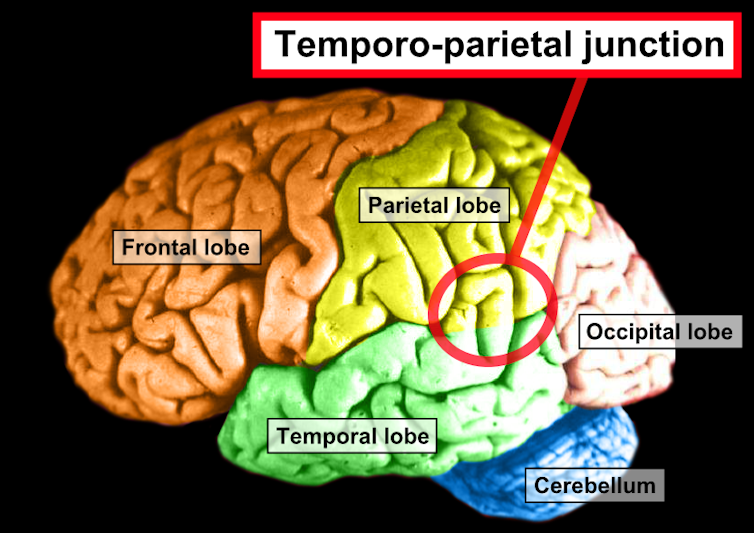We’ve all been there. You’re dying to grab that last piece of cake on the table during an office meeting, but you are not alone. Perhaps you just cut off a small piece – leaving something behind for your colleagues, who do exactly the same thing. And so you all watch the piece of cake getting smaller and smaller – with nobody wanting to take the last piece.
Whenever we make choices in a social setting about how much we want to share with others we must navigate between our own selfish interests and social norms for fairness.
But how fair are we truly? And under which circumstances do we offer others a fair share of the cake? Neuroscientific research has started revealing answers. Our own team used electric brain stimulation on 60 volunteers to figure out which parts of the brain were involved.
Humans have a strong preference for proactively conforming to social norms – even if there’s no punishment for not doing so. This has been extensively studied with economic games in which participants can decide how to distribute an amount of money between themselves and others.
Past research suggests that we simply prefer an equal split between ourselves and others. Interestingly, this is not only in situations when we are disadvantaged compared to others (disadvantageous inequity) and may have something to gain from the sharing of resources, but also in cases when we are better off than others (advantageous inequity).
This ultimately suggests that our sense of fairness isn’t solely driven by a selfish desire to be better off than others.
What’s more, the preference for a fair share between ourselves and others emerges early in childhood, suggesting it is to some extent hardwired.
The willingness to equally share resources with others persists even at the expense of sacrificing personal benefits. And when others give us an unfair share, we often feel a strong urge to punish them to protect our own interest. However, we typically do this even if it means that both of us end up with nothing in the end.
This raises the question of which psychological mechanisms support actions of different types of fairness decisions. Depending on whether we or the others find ourselves in a less favourable position, do the same psychological mechanisms drive our willingness to ensure a fair share with others?
Understanding others
One explanation for our tendency to be fair, even when we are better off than others, is that we understand other people’s perspectives. This might in fact encourage our willingness to sacrifice personal benefits for them.
Therefore, by taking the other’s perspective into account, we try to create a more equal environment by reducing inequality. Research has suggested that a small brain region facilitates our ability to navigate complex social environments: the right temporo-parietal junction (rTPJ).

The rTPJ plays a crucial role in understanding the thoughts and perspectives of others and might therefore help us make pro-social decisions. Given this, it has been proposed that this brain region contributes to our willingness to sacrifice personal benefits for the sake of others.
But what about when we’re not better off than others? It may be that advantageous and disadvantageous inequity are based on different psychological mechanisms, potentially represented in different brain regions.
Some researchers suggest that the right lateral prefrontal cortex (rLPFC), a brain region which drives the rejection of unfair offers and promotes the decision to punish social norm violators, might be involved. This is what ultimately makes us dislike being treated unfairly, particularly by those who are better off than us – unleashing negative emotions such as anger or envy.
Overcoming selfish motives
Our recent research offers new insights and reveals that the rTPJ and the rLPFC do indeed play different roles when it comes to fairness.
In our experiment, 60 participants made fairness decisions while undergoing a non-invasive type of electric brain stimulation called transcranial alternating current stimulation – applying a current to the scalp over a certain brain area to make it active. This enabled us to assess the involvement of specific brain regions.
Specifically, our study explored whether the same brain rhythms underlie the processes involved in making fairness decisions and take another’s perspective into account. We did that by electrically stimulating each brain area with different types of oscillations, or rhythms, and seeing how that affected people’s fairness decisions.
Our findings provide direct evidence that oscillations in the rTPJ play a crucial role for switching between one’s own and the other’s perspective. And when we do that, it ultimately helps us make proactive, fair decisions that also benefit others. A different type of underlying oscillation in the rLPFC instead seems to make people more utilitarian to overcome their less favourable position.
Future research will need to explore this link more deeply. But it does seem that fairness is not only driven by restricting one’s own selfish desires – which makes sense when you consider that cooperation is probably the single most important factor in the evolutionary success of our species. Being selfish doesn’t always make us successful.
However, the process of trying to make fair decision is, as we all know, complex. The fact that there are different brain regions involved in doing so ultimately shows why this is the case.
We all have the capacity to be selfish. But we are also simply hardwired to balance our own perspective with understanding the minds of others – and empathising with them.

